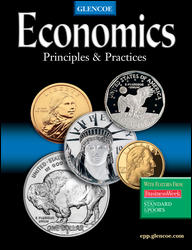
Economics Principles & PracticesChapter 11: Money and BankingChapter OverviewsChapter 11 deals with barter and the history of money and banking from early times to the modern period. Section 1 deals with money's function as a medium of exchange, a measure of value, and a store of value. Early money—including shells, dog teeth, feathers, and miniature iron spears—had these features. The United States dollar, which was based on the Spanish peso and named after the Austrian taler, also had these features. All successful moneys exhibit the characteristics of portability, durability, divisibility, and limited availability. Section 2 deals with the evolution of paper currency and the monetary standards used to maintain its value. From 1791 until the Civil War, the federal government printed coins, while privately-owned banks issued paper currency. In 1861 the government printed greenbacks to finance the Civil War. In 1863 the National Banking System (NBS) was established which issued its own currency called National Bank notes. Other currencies of the period included gold certificates, silver certificates, and Treasury coin notes. The gold standard, which made all currency convertible into gold on demand, was adopted in 1900 but was abandoned by 1934. Section 3 traces the development of modern banking under the NBS and the creation of the Federal Reserve System (Fed) in 1913. Other depository institutions, including mutual savings banks, credit unions, and savings and loan associations, also evolved to service the small investors that the commercial banks largely ignored. The factors that led to the S&L crisis in the 1980s-deregulation, high interest rates, fraud, and inadequate capital-led to the passage of FIRREA in 1989. FIRREA made thrift institutions subject to regulation by the federal Office of Thrift Supervision. The financial crisis was largely over by the end of the decade, and the 1990s saw the continued erosion of historical differences between the commercial banks, savings banks, and S&Ls. By the end of the 1990s, all financial institutions had returned to profitability. |  |















